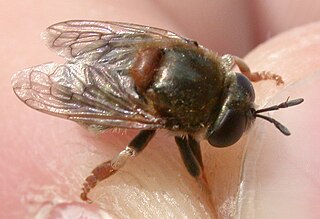
Hoverflies, also called flower flies or syrphids, make up the insect family Syrphidae. As their common name suggests, they are often seen hovering or nectaring at flowers; the adults of many species feed mainly on nectar and pollen, while the larvae (maggots) eat a wide range of foods. In some species, the larvae are saprotrophs, eating decaying plant and animal matter in the soil or in ponds and streams. In other species, the larvae are insectivores and prey on aphids, thrips, and other plant-sucking insects.

The subfamily Microdontinae contains slightly more than 400 species of hoverflies and, while diverse, these species share several characteristics by which they differ from other syrphids. The Microdontinae are myrmecophiles, meaning they live in the nests of ants. Larval Microdontinae are scavengers or predators in ant nests, and, in contrast to other syrphid larvae, have no readily apparent body segmentation. Some species also do not exhibit the typical adult flower-visiting behaviour of other hoverflies, but instead remain near their larval host colonies.

The Saint Helena olive is an extinct species of flowering plant. It is the only member of the genus Nesiota. It was endemic to the island of Saint Helena in the South Atlantic Ocean. Despite its name, it is unrelated to the true olive, but is instead a member of the family Rhamnaceae, the family which contains buckthorns and jujube. The last remaining tree in the wild died in 1994, and the last remaining individual in cultivation died in December 2003, despite conservation efforts. It is thus a prime example of recent plant extinction. The Saint Helena olive belongs to the tribe Phyliceae, which are mostly endemic to Southern Africa.
Arthur Loveridge was a British biologist and herpetologist who wrote about animals in East Africa, particularly Tanzania, and New Guinea. He gave scientific names to several gecko species in the region.

Eumerus is a genus of hoverflies, within the tribe Eumerini.

Platycheirus is a large genus of hoverflies. They are also called sedgesitters.

Sphaerophoria is a genus of hoverflies. Species slender 5.6-12mm long with extremely large hemispherical male terminalia after which the common name globetail has been created. There are bright yellow markings on head and thorax and usually on the abdomen but some species have a black abdomen. They can be found worldwide but are common in North America, Europe, Asia and Australia. There are over 73 described species.

Allograpta is a very large and diverse genus of hoverflies present throughout the world except most of the palearctic region. The adults are brightly coloured flower pollinators and most larvae have a predatory feeding mode involving soft-bodied sternorrhynchans. Certain species have diverged from this and their larvae have been found to be leaf-miners, stem-borers or pollen-feeders.
Afromicrodon is an African genus of hoverflies. The species of the genus Afromicrodon were previously and erroneously placed in the genus Ceratophya.
Spheginobaccha is a genus of hoverflies, with 15 known species. The genus is readily separated from other microdons by the incomplete metathoracic bridge, round/oval basoflagellomere, occiput with a dorsolateral crease, and other characters.
Surimyia is a genus of hoverflies, with three known species. They are small microdontine flies. Surimyia is the only hoverfly genus with the katatergum lacking microtrichia. In the subfamily Microdontinae, they are distinctive in the absence of pilosity on the postpronotum.

Milesia is a genus of very large hoverflies, which mimic social wasps. For example, the European species Milesia crabroniformis is a convincing mimic of the hornet species Vespa crabro. Milesia are predominantly Palaeotropical in distribution almost entirely Oriental.
Allobaccha is a genus of hoverfly with a large number of species. It was originally created as a subgenus of Baccha. Many species have an elongated wasp like abdomen and adults as well as larvae are predators of soft-bodied Hemiptera.
Exallandra is a subgenus of hoverflies in the subfamily Syrphinae, within the genus Sphaerophoria.
Sphaerophoria bankowskae is a European species of hoverfly.
Milesia afra is a species of hoverfly in the family Syrphidae.
Milesia bequaerti is a species of hoverfly in the family Syrphidae.
Milesia overlaeti is a species of hoverfly in the family Syrphidae.

Fazia is a genus of hoverflies, formerly treated as a subgenus of Allograpta, but now treated as a genus, though not monophyletic as presently defined.









